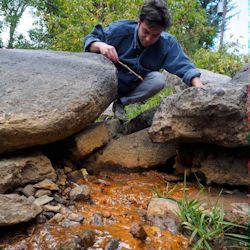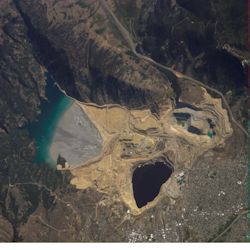SEJournal Online is the digital news magazine of the Society of Environmental Journalists. Learn more about SEJournal Online, including submission, subscription and advertising information.
TipSheet: Abandoned Mines — Stories Beneath Your Feet
If you’re looking for local stories to “mine,” then abandoned mines may be the environmental tale you’re looking to tell.
First off, there is probably one fairly near you. Counts vary, but there are probably hundreds of thousands in the United States. While they are more numerous in the West, they are found in most states.
Secondly, for environmental journalists, such sites can affect your readers’ lives in many ways.
Sometimes the problem is just an unmarked, unguarded mine shaft that people can fall into. But often they are environmental issues, as mining companies historically abandoned them without cleaning them up, often just going out of business and vanishing.
Despite that, federal laws to prevent or undo resulting pollution are limited. EPA’s Superfund hazardous waste cleanup program may be applicable in a few of the worst cases. The Surface Mining Control and Reclamation Act applies only to surface mining of coal, and includes a fee for cleanup of mines begun before it was passed in 1977.
 |
| Student journalist Sam Schanfarber of the University of Colorado Boulder examines rust-colored residue in the Animas River near Durango, Colorado, during a 2015 reporting trip on the Gold King Mine blowout. Photo: Roxann Elliott, Flickr Creative Commons |
But for hard-rock mining on federal lands, legally, it is pretty much the “wild west.” Sometimes, the mess is spectacular, as with the Berkeley Pit near Butte, Montana, measuring a mile long by half a mile wide.
In many cases, the abandoned mine works fill with water, which becomes acidified, and leaches toxic metals like copper, arsenic, cadmium, lead, mercury and zinc. In heap leach mining operations, heavy metals may be joined by compounds like cyanide and sulfuric acid. Acid mine drainage affects even upper branches of the Potomac River, which runs by the nation’s capital.
The 2015 Gold King spill marked a milestone in misunderstanding of the abandoned mine problem — often abetted by news media. An environmental disaster it certainly was, but one replicated in low-key ways across the country every day.
Gold King became an opportunity for political opponents to scapegoat the U.S. Environmental Protection Agency, rather than the other agencies which had avoided responsibility or the mining ventures that had created the problem (may require subscription) more than a century earlier.
States like Nevada, which have high numbers of abandoned mines, are a mother lode. An example is the Anaconda Copper Mine site in Lyon County — which the state asked EPA not to put on the Superfund cleanup list.
Databases help, but leave gaps
As a journalist, you might think the public has a right to know about where the abandoned mines are and what threat they present.
But the government apparently keeps them hidden to prevent you from falling into one of them. When active mining operations unknowingly cut into abandoned mine works, however, flooding and other harm can result.
So if you are looking for abandoned mine stories, you may be helped by a number of databases — although none of them is perfect or complete.
 |
| Berkeley Pit, a former mining site and federal Superfund site near Butte, Montana, as viewed from the International Space Station in 2006. Photo: NASA |
- Probably the most abandoned mine lands are on the turf of the Bureau of Land Management. BLM has tried to keep an inventory of its more than 52,000 sites, although it is not online or searchable. You might try your BLM state office. BLM also has a list of abandoned mines program contacts.
- The Office of Surface Mining Reclamation and Enforcement maintains a database called e-AMLIS, which primarily covers coal mining sites. It is online and searchable to authorized users, but not to the general public.
- The non-profit group SkyTruth has mapped 48,500 sites from e-AMLIS, so they are mostly coal sites.
- The federal government has an interagency program on abandoned mines, whose website is informative but does not offer site data. (If you get a message saying its security certificate is expired, you can safely ignore it.)
- The U.S. Geological Survey has also mapped many abandoned mine sites. These are downloadable in GIS form, but are usually site-specific.
- EPA itself has a list of abandoned mine inventories with (sometimes) useful links. It includes agencies you wouldn’t expect, like the National Park Service.
- Other useful resources may be found at your state mining agencies. The Mine Safety and Health Administration has a list of links to state agencies that may offer maps of abandoned mines. Here is an example for Virginia.
- Many other abandoned mine datasets, some specialized on things like uranium, can be found on the federal site data.gov.
A final news note: In hard-hit coal-reliant communities (the ones President Donald Trump promised to save), abandoned mine reclamation projects can provide meaningful employment. In his 2019 budget, Trump proposed eliminating the Abandoned Mine Land Pilot Program, which would provide such jobs.
* From the weekly news magazine SEJournal Online, Vol. 3, No. 9. Content from each new issue of SEJournal Online is available to the public via the SEJournal Online main page. Subscribe to the e-newsletter here. And see past issues of the SEJournal archived here.













 Advertisement
Advertisement 



